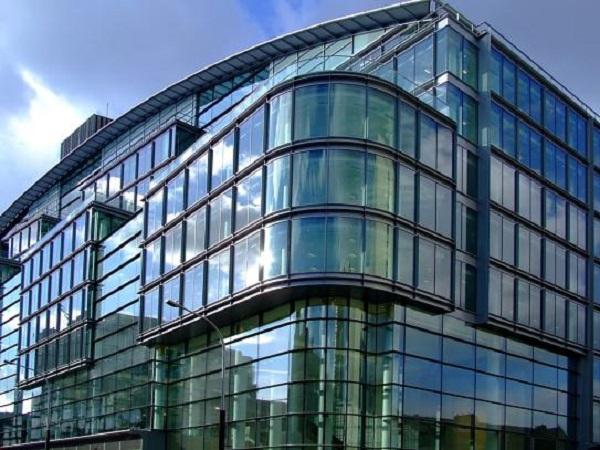Exterior Systems
The basic function of the exterior system or enclosure of a building or structure is to protect the covered or otherwise conditioned interior spaces from the surrounding environment. This fundamental need for shelter is a concept that is as old as the recorded history of mankind. However, as our needs have evolved and technologies have advanced, the demand placed on designers to both understand, and integrate, a wide range of increasingly complex materials, aluminum, glass, components, and systems into the building enclosure has grown in equal proportion.
Aluminum Curtain Walls
Curtain walls are an excellent way to bring natural light into a room while remaining protected from the elements. All curtain walls manufactured by Solar are constructed out of durable aluminum. The benefit of an aluminum curtain wall is the reduction in required maintenance. Aluminum curtain walls will not rot, rust, warp, expand with heat, or require constant finishing.
Curtain Wall
With the allure of urban life only growing, designers and developers must find a way to accommodate an increasing population within the limits of existing cities. Space restrictions mean building up, not out, while still providing inviting and well-built condos, offices and commercial spaces.
Curtain and window wall systems are a popular choice as they add design interest to architecture, as well as allow for maximum light within a building’s space. Here’s a breakdown of the difference between the two wall systems, plus the positives and drawbacks of both.
Spider Curtain Wall
Spider Glazing is a part of the frame-less glass system where they provide a flush external appearance with uninterrupted views. Spider Glazing curtain walls provide maximum daylight for building interiors, as well as the possibility of placing large transparent glass surface as building envelopes. Due to its visual attractiveness such architectural building envelopes are commonly used on commercial buildings to create premium building skills. A wide variety of applications are available including curtain walls, canopies and atriums, allowing maximum transparency and brightness optimization and unique design.
Spider Glazing Specifications
• Spider glazing is a very flexible and contemporary design medium that can create designs with vast expanse of glass, frame-less entrances and canopies.
• All doors and windows can be inserted in the spider glass area.
• Tempered or heat soaked glass can be used in spider glazing systems so as to have the performance of a safety glass facade. The glass thickness that is used is usually 12mm thick.
• The spider glazing is designed to resist wind pressure. It can be fixed with either 2 way spiders or 4 way SS spiders fitting options. Fin glass support could also be used to resist wind pressure.
• Silicone Sealants and gaskets are used to make the glass frames watertight.
• Allows full penetration of natural light into the interiors, certain types of glass prevent the absorption of UV light.
• Spider glazing is easy to install and maintain.
Window Wall
Unlike other building materials, a curtain wall system is thin and lightweight, usually aluminum and glass. These walls are not structural, and by design, they are only able to carry their own weight, while transferring the load of wind and gravity to the structure of the building. The design makes it air and water resistant, to ensure that the interior of the building remains airtight.
System types
Curtain walls are available in three main systems: face-sealed, water-managed, and pressure-equalized. Face-sealed walls depend on perfect sealing between units of the wall and frame. Water-managed systems include moisture drains to prevent the intrusion of water in the building. However, neither face-sealed or water-managed systems create an air barrier.
The pressure-equalized system blocks all forces while keeping the building’s interior air-tight. The outside framing is designed to wash away water and prevent penetration. This is the strongest system, which provides a reliable resistance to air and water.
Benefits of curtain walls
The use of curtain walls has many advantages. Because of the use of lightweight materials, curtain wall systems are an affordable option for a building’s exterior casing. Depending on the size of the building, the savings may be compounded.
Because of the system’s ability to resist air and water infiltration, curtain walls are energy efficient. This will reduce your cost of heating, cooling, and lighting the building. So in addition to saving you money on construction, it has long-term savings benefits.
Another benefit of the curtain wall system is that it can be installed in small or large units, depending on the needs and preference for your project. The walls may span the distance of the floor to ceiling or be installed across multiple floors. This allows for a greater flexibility in design.
In part because of the versatility of the system, curtain walls are an attractive modern-looking option for you any building exterior.




